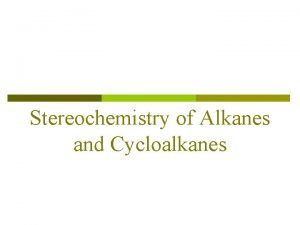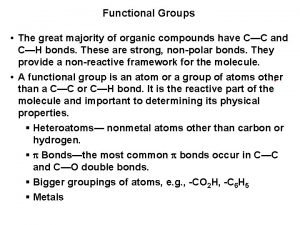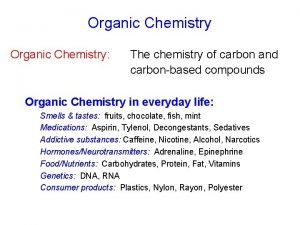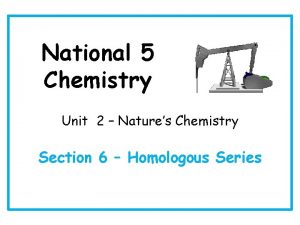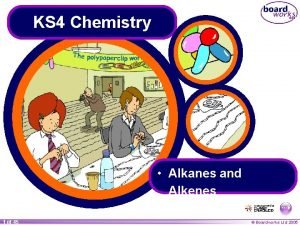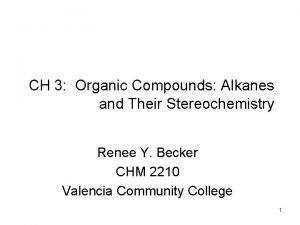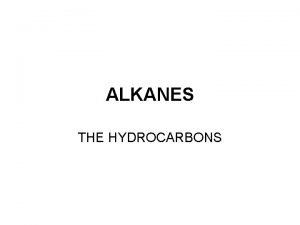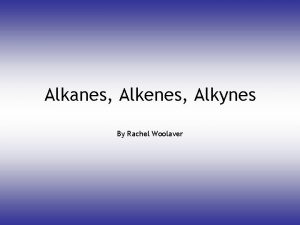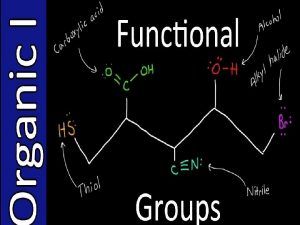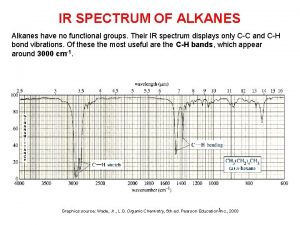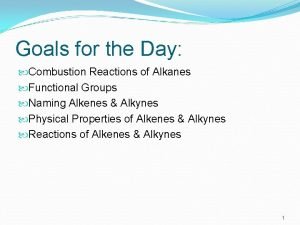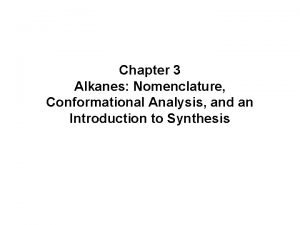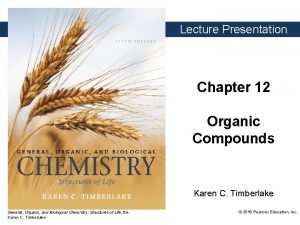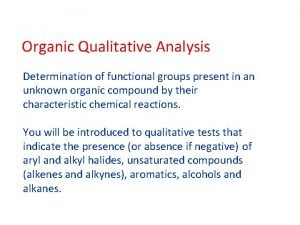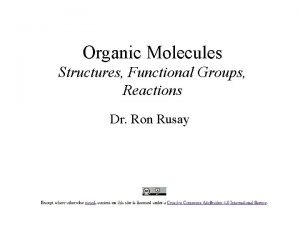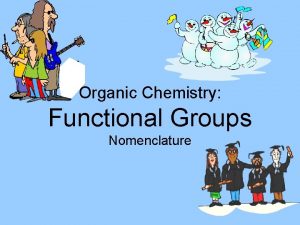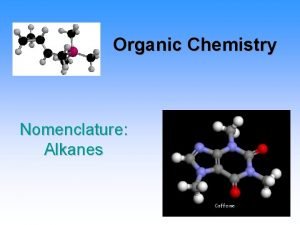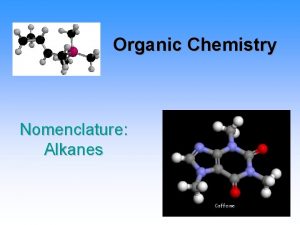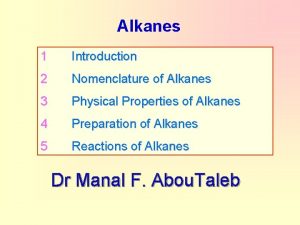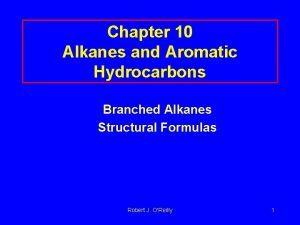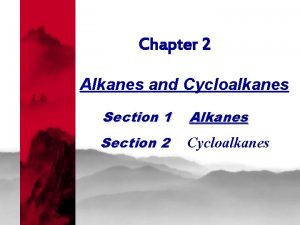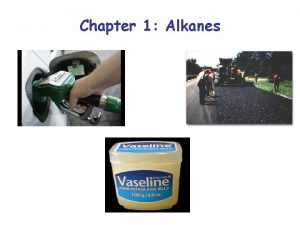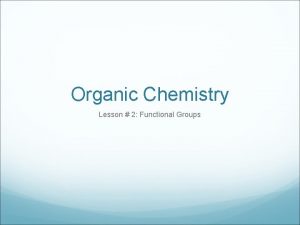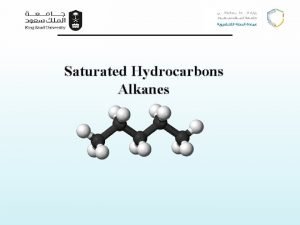Chapter 5 Functional Groups and Nomenclature I Alkanes




























- Slides: 28

Chapter 5: Functional Groups and Nomenclature I Alkanes a subgroup of hydrocarbons: contain only C and H only have C-C single bonds Cn. H 2 n+2 DU = 0 no functional group Cycloalkanes have a ring low melting, low boiling, hydrophobic

Common Nomenclature of Alkanes from rancid butter (butrium) butyric acid butane (straight chain, normal) isobutane (branched) pentane isopentane neopentane

Systematic Nomenclature of Alkanes developed by the International Union of Pure and Applied Chemistry (IUPAC)

Step 1 Find the longest continuous carbon chain in the compound. The number of carbons in this backbone determines the root. If there are two or more chains of equal length, choose the one with more branches.

pent- or incorrect more branches oct-

Step 2 Attach suffix -ane for an alkane pentane Step 3 Number the carbons in the root chain. Start from the end that gives the lower number to the carbon where the first branch occurs. If a tie, then proceed to the second branch, etc.

5 4 3 2 1

Step 4 Name the groups. root + -yl

Step 5 Assemble the name: number-grouprootsuffix 2 -methylhexane 3 -ethyl-2, 5 -dimethylhexane

Complex Groups (groups with branches) 2 -methyl-5 -(1 -methylpropyl)nonane To name a branched group: choose the longest chain beginning with C attached to root chain; begin numbering at the C attached to root chain; use –yl suffix; put entire group name in parentheses. (1 -methylpropyl)

Some additional terminology


Systematic Nomenclature of Cycloalkanes root = number of C’s in ring prefix = cyclo number beginning at one group so numbers are as small as possible cyclohexane 1 -ethyl-3 -methylisobutylcycloheptane cyclopentane or (2 -methylpropyl)cycloheptane

If the alkyl chain has more carbons than the ring, then name as an alkane with a cycloalkyl group. 5 -cyclopentyl-2 -methylheptane

Alkenes have C=C (unsaturated, will react with H 2, has pi bond) Nomenclature find the longest chain with both C’s of the double bond suffix = -ene (-diene, -triene) number from end so C=C has lower number designate position of C=C using number of first C of C=C 7 -methyl-2 -octene or 7 -methyloct-2 -ene

3 -ethyl-1, 2 -dimethylcyclohexene 2 -propyl-1, 3 -cycloheptadiene

Common Names

Alkynes has (unsaturated) Nomenclature very similar to alkenes suffix is -yne 5 -ethyl-6 -methyl-2 -heptyne 3 -propylpent-3 -en-1 -yne

Alkyl Halides R-X halogens are named in the prefix as groups fluoro- chloro- bromo- iodo- 2 -chlorobutane or sec-butyl chloride 1 -bromo-3 -ethylcyclopentane

Alcohols R-OH (hydroxy group) Nomenclature choose longest chain containing the C bonded to the OH number so the C bonded to the OH has the lower number suffix: replace –e of hydrocarbon name with –ol 2 -propanol or isopropyl alcohol 3 -cyclohexenol

3, 4 -dichloro-3 -buten-2 -ol or 3, 4 -dichlorobut-3 -en-2 -ol 2 -methyl-1, 4 -cyclohexanediol 1 -propanol a primary alcohol 2 -pentanol a secondary alcohol 1 -methylcyclopentanol a tertiary alcohol

physical properties of alcohols -OH group is polar and can form hydrogen bonds CH 3 CH 2 CH 2 CH 3 pentane 72 g/mol mp -130 o. C bp 36 o. C CH 3 CH 2 CH 2 OH 1 -butanol 74 g/mol mp -90 o. C bp 117 o. C Hydrogen bonding has a larger effect on boiling points because the H-bond must be broken for the molecule to get into the gas phase. -OH group is hydrophilic ethanol miscible with water 1 -pentanol 2. 7 g/100 m. L of water 1 -heptanol 0. 1 g/100 m. L of water

Ethers R-O-R’ Nomenclature common names: group ether methyl propyl ether systematic – RO named as group in the prefix R-O- alkoxy group (replace –yl with –oxy in group name) 2 -methoxy-2 -methylpropane methyl t-butyl ether (MTBE) 5 -ethoxy-2 -cyclohexenol

Solvents diethyl ether “ether” tetrahydrofuran THF dioxane

Amines derivatives of ammonia NH 3 R-NH 2 R 2 NH R 3 N R 4 N+ X Nomenclature common butylamine a primary amine a secondary amine a tertiary amine a quarternary ammonium salt groupamine trimethylamine N-ethyl-N-methylcyclohexylamine

Systematic Nomenclature of Amines similar to alcohols replace –e of hydrocarbon name with –amine N, 6 -dimethyl-2 -heptanamine N-ethyl-3 -isopropylhex-5 -en-2 -amine

physical properties of amines less polar than alcohols primary and secondary amines can form hydrogen bonds weaker because N is less electronegative than O CH 3 CH 2 CH 2 NH 2 bp = 78 o. C CH 3 CH 2 CH 2 OH bp = 117 o. C low MW amines often have ammonia-like or fishy odors

Compounds with Both an OH Group and an NH 2 Group methylamino group 7 -methylamino-3 -octanol A name cannot have both –ol and –amine in the suffix. By convention, alcohols have higher priority than amines. Group name for –NH 2 is amino-.
 Priority sequence of functional groups
Priority sequence of functional groups Bond angle in cyclohexane
Bond angle in cyclohexane How are ethnic groups and religious groups related
How are ethnic groups and religious groups related Nonpolar functional groups
Nonpolar functional groups Functional and non functional space maintainer
Functional and non functional space maintainer Functional and non functional plasma enzymes
Functional and non functional plasma enzymes Enzymes of blood plasma
Enzymes of blood plasma Functional and non functional
Functional and non functional Alkanes solubility
Alkanes solubility Halogenation of alkanes mechanism
Halogenation of alkanes mechanism Alkane molecular formula
Alkane molecular formula Uses of alkanes
Uses of alkanes Alkanes list
Alkanes list General formula for alkyl group
General formula for alkyl group Alkanes alkenes alkynes
Alkanes alkenes alkynes Alkanes list
Alkanes list Ir spectra of alkanes
Ir spectra of alkanes Combustion reaction of alkanes
Combustion reaction of alkanes Alkane complete combustion
Alkane complete combustion Alkanes def
Alkanes def Alkylation of alkanes
Alkylation of alkanes Viscosity marble experiment
Viscosity marble experiment Cyclopentane uses
Cyclopentane uses Iupac stands for
Iupac stands for Test for alkenes
Test for alkenes Prefix for alkanes
Prefix for alkanes Uses of alkanes
Uses of alkanes Qualitative analysis of organic functional groups
Qualitative analysis of organic functional groups Functional groups in aspirin
Functional groups in aspirin

